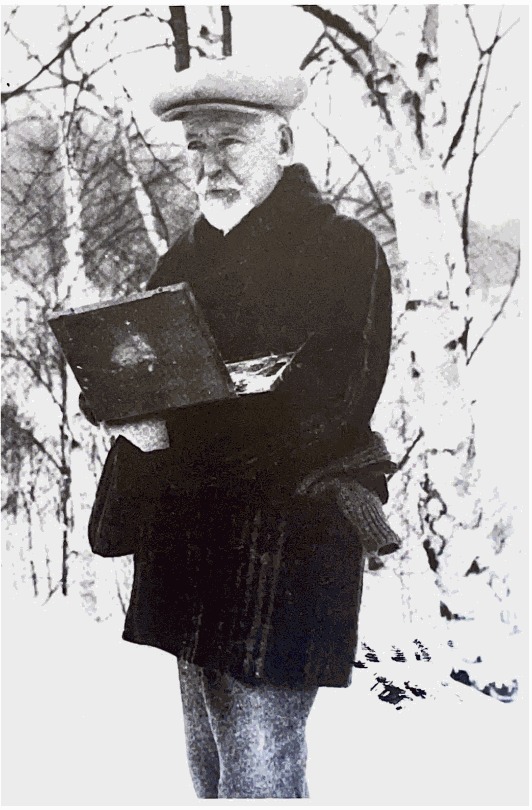Canadian Impressionism: Plein Air Painting in focus

Maurice Cullen painting en plein air
Impressionism is about plein air painting. Not only is the content of impressionist painting usually outdoors, either urban or country, but the artists also took the act of painting outside, en plein air. This style is synonymous with capturing fleeting moments of light and color. It’s about the pleasure of painting. Impressionist artists in Canada usually painted an oil sketch on the spot, outdoors, on a small panel/pochade.
Maurice Cullen 1866-1934, The Devil's River near Mont-Tremblant, 1931 (circa).
Oil on canvas. 24 1/4 x 32 1/4 in (61.6 x 81.9 cm). Alan Klinkhoff Gallery Cullen Inventory No. AK1176.
This artwork is available for purchase.
Maurice Cullen’s monumentally beautiful large-scale painting above only became possible because he was initially able to capture the magnificence of the light and colour on the spot, seeing it while snowshoeing about, and to commit the scene to a pochade. As we have copied elsewhere, “the process of capturing the moment in a sketch was the essential creative event.” When he chose to resolve a sketch into a large format, a large canvas, this he did later in his studio.
View additional paintings by Maurice Cullen
This process of plein air painting was only possible due to a new development in artist supplies, the availability of a portable pochade box or sketch box, “a portable studio in a box”. The sketch box contained a few brushes, a few pochades/panels and a selection of oil paints in tubes. As an aside, although paint had become available in tubes in the mid 19th Century, the increasing interest in painting outdoors, in part stimulated by the impressionists’ habit, led to a growth industry in paint manufacturers to develop a greater quantity and variety of colours for artists. Prior to these developments, on the spot sketch would have been executed by an artist in graphite on paper or conceivable watercolour on paper. Neither could have succeeded in recreating the tapestry of light and colour to his interest. This new ability to sketch in oils outdoors explains why so few drawings by Cullen exist.
James Wilson Morrice 1865-1924, South Portal of Saint-Jacques de Dieppe, 1909 (circa).
Oil on wood panel. 6 x 4 7/8 in (15.3 x 12.3 cm).
This artwork is available for purchase.
Looking at this precious and delicately painted sketch, one cannot help but think of Claude Monet’s series of 30 paintings of the Cathedral at Rouen, when he was captivated by the light and colour on the cathedral facade at different times of the day and in varying conditions. Here, Morrice is spontaneously stimulated by a similar event.
"[Morrice’s] small sketches are true pochades, small pocket-sized paintings, which he would keep in the box while strolling around. When a scene caught his interest, he would make a rapid sketch of it. Morrice would later work some of these small sketches into larger paintings, although, more often than not, the process of capturing the moment in a sketch was the essential creative event. Morrice, a versatile and often spontaneous painter, had several of these boxes since they were critically important for the way he worked."
View additional paintings by James Wilson Morrice
Robert Pilot 1898-1967, Schooner Loading, 1919.
Oil on panel. 10 3/4 x 14 in (27.3 x 35.6 cm).
This artwork is available for purchase.
View additional paintings by Robert Pilot
Oil on panel. 6 x 9 in (15.2 x 22.9 cm).
Lucile Rodier Gagnon Inventory No. 149.
This artwork is available for purchase.
Walking about en plein air with his sketch box over his shoulder, Clarence Gagnon was able to sense the splendour of light and colour this scene offered and to commit the scene to his panel on the spot. It is a genuinely beautiful and entirely natural composition of autumn trees, the running stream with a backdrop of houses and a blue sky capped with billowy white clouds. Clarence Gagnon's most important legacy to Canadian art collectors is the quality and quantity of plein air sketches he painted of the Charlevoix region around Baie St Paul.
His beveled sketch panels, typically around 5" x 7" or 6" x 9", are instantly recognizable and unique in Canadian art.








Add a comment